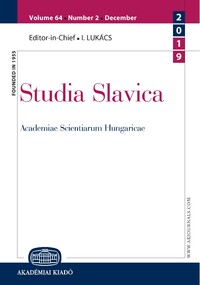Разновидности текстовой динамики в свете феномена признаковости в повести Ф. М. Достоевского «Двойник» (Статья первая)
Types of Textual Dynamics in the Light of the Phenomenon of Semantic Attributes in Fyodor Dostoevsky’s Novella The Double (Part 1)
Author(s): Katalin KroóSubject(s): Semiotics / Semiology
Published by: Akadémiai Kiadó
Keywords: Dostoevsky; The Double; text-dynamics; recursivity; transpositional dynamics; transformation; integration; semantic attributes; motoric-verbal expression; semiotics
Summary/Abstract: The paper examines the poetic principles and functions of two sorts of structural-semantic logic influencing the emergence of textual dynamics in The Double. Paradoxically, the main developmental line consists in a highly repetitive structure of permanent reiteration of fixed narrative units, motifs, and lexical items in the text. Their constant recurrence (cf. events, character traits, semantic attributes, and elements of stable idiomatic phrases) creates the impression of a static world model in which no changes occur. This may be called recursive dynamics under the sign of a static state. Transpositional dynamics, on the other hand, can be regarded as the second direction of the textual developmental movement, producing the mechanism for meaning-generation. Transposition is interpreted broadly, in the paper, with a special accent on 1) meaning transfigurations and projections through the shift from the uniformity of semantic attributes to the acquiring of new attributes by the signifier or the signified (the problem of reference); 2) processes of semantic integration concerning the inclusion of smaller semantic units into larger ones (semantic attribute → motif → character figure). The purpose of the paper is to clarify the reciprocity (the special interaction) of the two types of dynamics. The semantic formation under scrutiny embodied by the smallest unit of Golyadkin’s motoric-verbal expression has a double orientation based on the correlation of motion and stop interpreted by V. Vinogradov in his famous study. From the perspective of the paper’s research object, this narrative and linguistic unit is examined as a recursive motif pair with a special capacity of transformation through transposition. It is demonstrated in detail, within the close reading of the fift h chapter, where Golyadkin’s double appears, how transposition works through a process of semantic integrations. The meaning of enemy is shift ed from human rivals to Petersburg weather and human fate as new subjects, associated with mythology and literary culture (intertexts), leading up to the interpretation of Golyadkin’s personality. The protagonist’s figure is projected upon his double through many semantic attributes. The “melancholy flight” as his encounter with himself presents him as an awakening hero, who as a character is developed gradually, including his double as his figure-transposition which also embodies a dynamic semantic pattern. The correlation of Golyadkin and his double in the context of firstness and secondness is also put into the context of Peircean semiotics.
Journal: Studia Slavica Academiae Scientiarum Hungaricae
- Issue Year: 65/2020
- Issue No: 1
- Page Range: 81-96
- Page Count: 16
- Language: Russian

